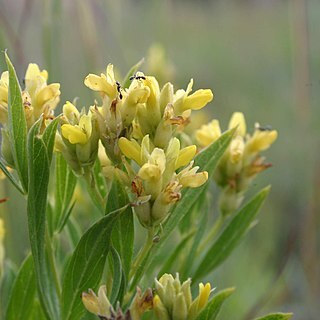Calyx not or slightly inflated; lobes rarely subequal, usually with the upper sinuses slightly to much shallower than the lower sinuses, the lateral sinuses sometimes the shallowest, the lowest lobe narrower than the others.
Stamens in a sheath open on the upper side and not much longer than the free parts, the vexillary filament sometimes free; anthers narrowly oblong, subequal, but 6 (including the carinal one) attached higher up.
Inflorescences terminal or leaf-opposed, the flowers in racemes or solitary on long peduncles, sometimes resupinate; bract and bracteoles linear to elliptic-obovate.
Pods sessile, linear-oblong to ellipsoid, pointed, laterally compressed, dehiscent, 1–many-seeded.
Leaves digitately 3-foliolate; stipules linear to foliaceous or lacking.
Seeds ± oblique-cordiform, with a small hilum.
Style nearly straight or pointed downwards.
Perennial herbs or small shrubs.
